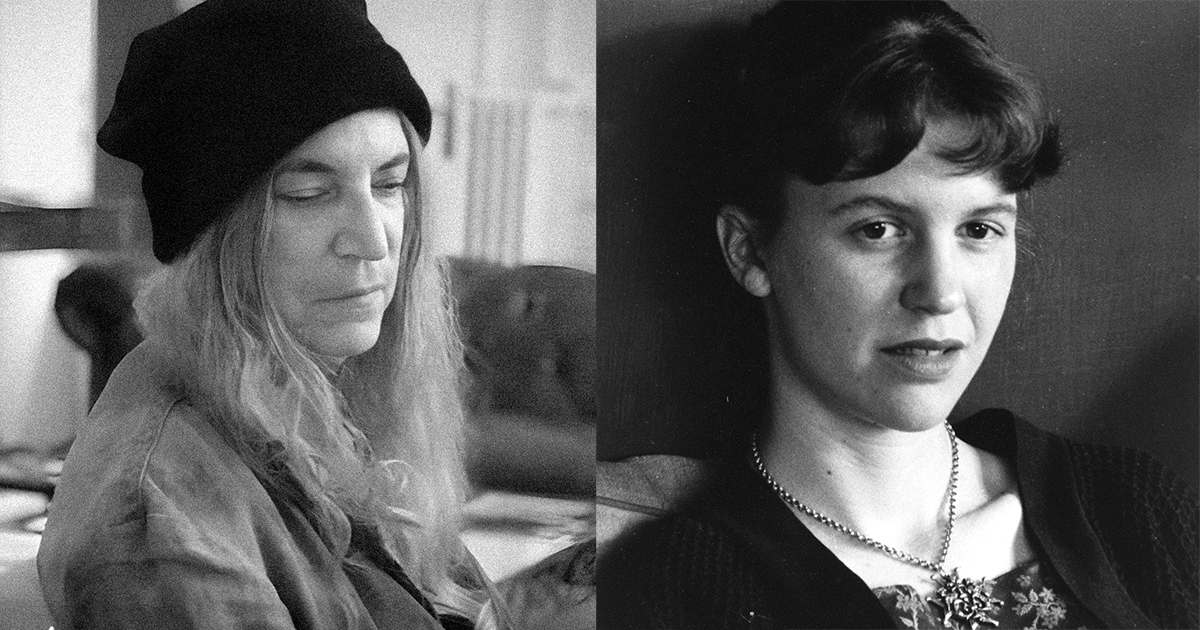Patti Smith Reads Sylvia Plath’s Poem, “The Moon and the Yew Tree”

Court Green, the rural Devon property Sylvia Plath called home for sixteen months toward the end of her life is a popular pilgrimage for Plathophiles, seeking to worship at the wellspring of some of her best known poems – The Bee Meeting, Daddy, Lady Lazarus, and many other works posthumously published in 1965’s Ariel.
(Her ex-husband Ted Hughes wrote his collection, Crow, there as well, not long after Plath died by suicide. Something tells us his widow, Carol, a staunch defender of her husband’s legacy, doesn’t exactly roll out the welcome mat when she sees starry eyed devotee’s of her husband’s first wife tromping around the perimeter of the property where she still lives…)
Plath scholar Dorka Tamás made the trip to St. Peter’s, the North Tawton church abutting Court Green. Plath took pleasure in describing its grounds in letters to friends and family, and immoratlized its massive yew in “The Moon and the Yew Tree”:
I looked around the Victorian gravestones, slowly passing the souls of the dead. The beautiful green trees could not contrast more with the Neo-gothic church. I knew at first sight which one is the yew tree in Plath’s poem. I was searching for the window of Court Green, Plath’s office window, from which she could have an expansive view of the yew…North Tawton has been an ambiguous place for both Plath and Plathians. In the year she spent in the isolated village, she produced her best and most well-known poems, but it was also a place where she experienced extreme isolation after Hughes left her. Nevertheless, the country life provided plenty of opportunities for Plath to explore her creative, aesthetic, and domestic independence, such as horse riding in the field of Devon, experimenting with beekeeping, painting her children’s nursery elbow chair, and making apple pie from the apples of her garden. The poetry and fiction Plath wrote between autumn 1961 and winter 1962 are embedded in the natural environment in Devon and community, places, and non-human life of North Tawton.
Poet David Trinidad, an avid collector of Plath-related memorabilia, whose souvenirs include a vial of dust from the studio she occupied during a residency at Yaddo and a facsimile of a blue patterned Liberty of London scarf she gave her mother during a 1962 visit to Court Green, prizes his cuttings from St. Peter’s yew:
Plath wrote The Moon and the Yew Tree on October 22, 1961, less than two months after moving to Court Green. Everything in the poem is true: her property was separated from an adjacent church by a row of headstones; on Sunday eight bells would toll; an ancient yew tree grew in the church graveyard. …She doesn’t mention the yew tree specifically in any of her letters; she saved that for the poem.
Godmother of Punk Patti Smith, whose souvenirs run more toward Polaroids, wrote of visiting Plath’s grave in her memoir, M Train, and identifies the poet as someone who makes her want to write.
Her performance of “The Moon and The Yew Tree,” above, is more straightforward than Plathian, allowing the darkness of the work–which The Marginalian’s Maria Popova calls “one of (Plath’s) finest poems and one of the most poignant portraits of depression in the history of literature”–to speak for itself.
As Popova notes, the poem was written during a difficult period, in an attempt to fulfill a writing exercise suggested by Hughes, “to simply describe what she saw in the Gothic churchyard outside her window.”
Who would dare fault Plath for obeying the impulse to editorialize a bit?
The New Yorker had accepted but not yet published “The Moon and the Yew Tree” when Plath took her own life on February 11, 1963. It was published posthumously in a two-page spread along with five other poems six months later. You can read it online here.
via The Marginalian
Related Content
Why Should We Read Sylvia Plath? An Animated Video Makes the Case
Hear Sylvia Plath Read 18 Poems From Her Final Collection, Ariel, in a 1962 Recording
Hear Patti Smith Read 12 Poems From Seventh Heaven, Her First Collection (1972)
– Ayun Halliday is the Chief Primatologist of the East Village Inky zine and author, most recently, of Creative, Not Famous: The Small Potato Manifesto and Creative, Not Famous Activity Book. Follow her @AyunHalliday.


